During the Renaissance period, spanning from the 14th to the 17th century, wine-making underwent a significant transformation that echoed the wider cultural rebirth occurring across Europe.
You might imagine the era’s art, science, and literature as its most lasting contributions, but the evolution of viticulture stood as a parallel narrative, shaping the social fabric and economies of the time. Wine was more than a beverage; it served as a social lubricant, a symbol of status, and a considerable point of trade that influenced laws and societal norms.
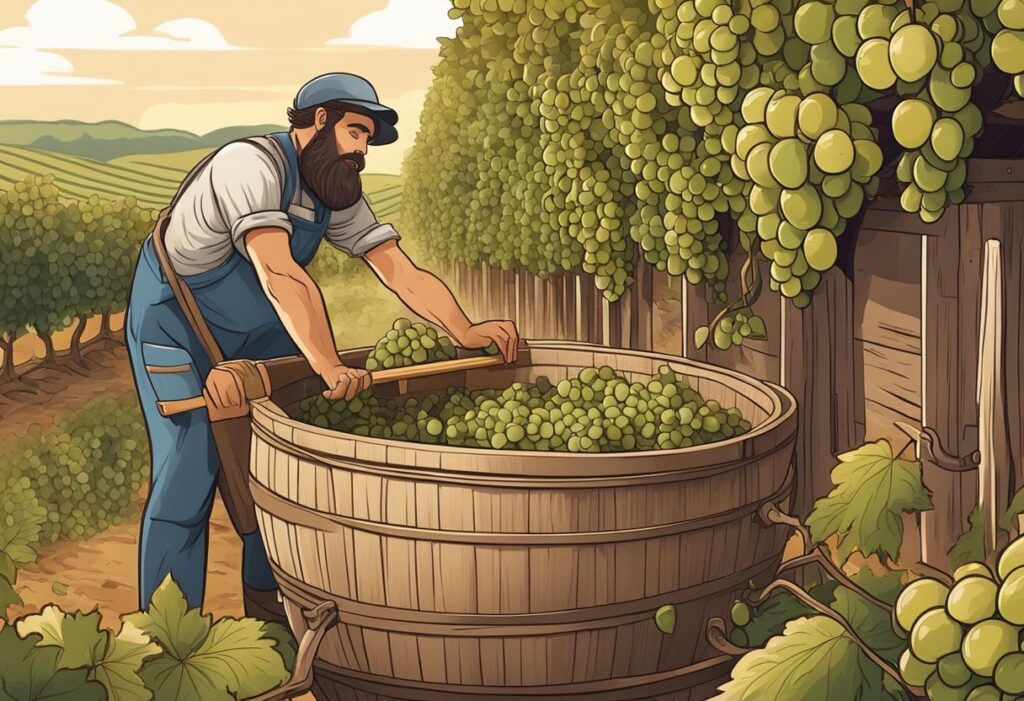
In particular, regions in France and Italy became famous for their distinct wines, with each area developing unique grape varieties and winemaking techniques adapted to their specific terroirs.
Advancements in technology and an improved understanding of grape cultivation contributed to refining the aesthetics and quality of wines produced. As the Renaissance spread across Europe, so did these innovations, ultimately affecting the legal frameworks, bolstering trade routes, and leaving a cultural legacy that informs modern oenology.
Key Takeaways
- Renaissance winemaking mirrored the period’s innovation and cultural shifts, significantly impacting European society.
- Technological and agronomic advancements during this time laid the foundation for modern viticulture practices.
- Wine’s economic and social influence prompted changes in law and trade, with enduring cultural resonance.
Historical Context of Renaissance Wine-Making
The Renaissance marked both a revival of classical learning and profound developments in viticulture, fundamentally influencing European wine culture. This period saw a transformation from medieval practices to a more refined winemaking approach inspired by art, history, and logic.
Evolution from the Dark Ages to Renaissance
During the Dark Ages, wine was a basic necessity, providing calories and hydration, often safer to drink than water. With the Renaissance, a period defined by revival and rebirth, winemaking transitioned from mere survival to a form of art. The era borrowed heavily from Greek and Roman practices, seeing a return to the use of Roman-inspired amphorae for storage and aging of wine.
Influence on European Wine Culture
The Renaissance era’s investment in sciences and techniques had a significant impact on the quality of wine. The grape became more than just fruit; it was a medium for experimentation and expression of regional identities. Influential figures in Renaissance viticulture pushed for advancements in growing methods and harvesting, aligning with the broader cultural movements of the time and profoundly influencing wine’s role in society.
Iconic Renaissance Figures in Viticulture
Notable individuals aligned with the humanistic principles of the Renaissance contributed to winemaking. Their intrinsic belief in the power of human reason and empirical observation led to improved understanding of vineyard management and fermentation processes. These advancements allowed winemakers to craft wines that were as revered as the era’s most celebrated works of art.
Through active engagement with the legacy of the ancients, and a renaissance in the approach to viniculture, wine culture during the Renaissance became a reflection of the era’s ethos — creating a history of wine that was both profound and enduring, much like the era’s iconic art and logic.
Technology and Techniques
In the Renaissance, innovative practices transformed the wine-making process significantly. You’ll explore how technological advancements and evolved techniques shaped viticulture and wine production during this era.
Renaissance Viticulture Innovations
Renaissance viticulture saw the adoption of more precise agricultural practices which improved grape quality. The understanding of vineyard terroir – the role of geography, geology, and climate – became more prominent. This period also marked increased use of tools like the hoe and plough for better soil preparation, leading to healthier vines.
Fermentation and Vinification Advances
During fermentation, winemakers began to recognize the importance of temperature control to prevent spoilage and manage the conversion of sugars into alcohol. Renaissance wine producers also started the practice of monitoring the fermentation process more closely, leading to the creation of more consistent and higher quality wines.
Barrel Making and Storage
The craft of barrel making, or cooperage, was refined during the Renaissance, significantly affecting wine storage and aging. The development of tighter-sealing casks allowed for better control of wine’s exposure to air, crucial for the aging process. Using different woods, primarily oak, also introduced new flavor profiles, leading to the complexity that is still appreciated in wines today.
Grape Cultivation and Terroir
In your journey through Renaissance wine-making, understanding the nuances of grape cultivation and the significance of terroir is paramount. Let’s explore how grape varieties, climate, and the land itself craft the essence of the wine.
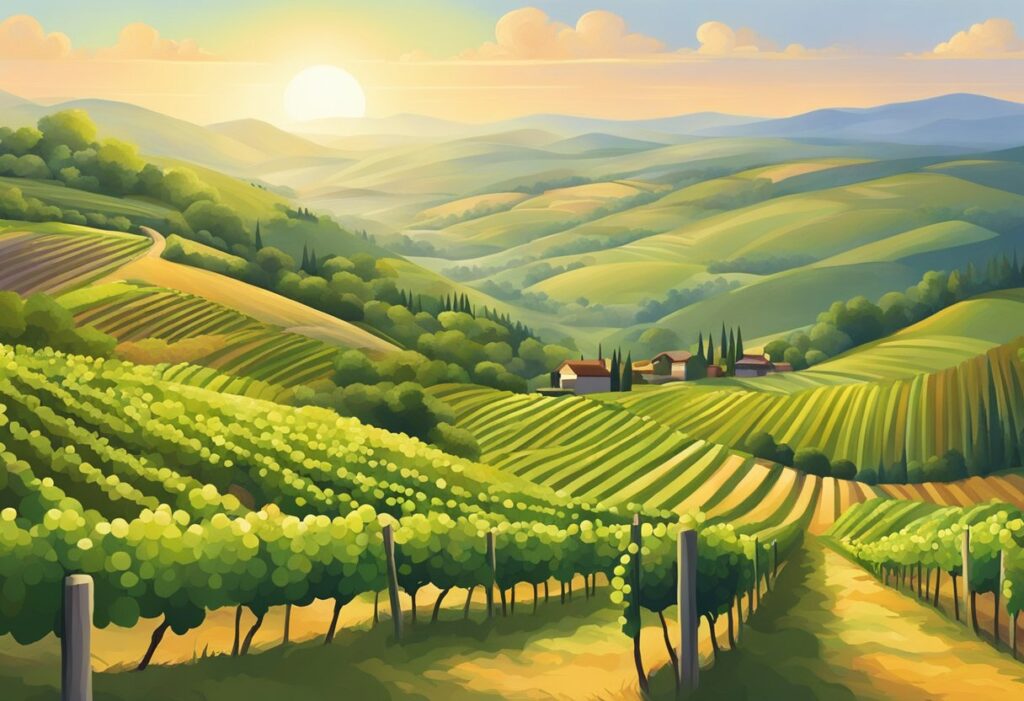
Regional Grape Varieties
In Renaissance times, you would find a diverse range of grape varieties meticulously selected and cultivated to suit their regional environment. Each variety bore unique characteristics that were a testament to its locale. For instance, Sangiovese grapes thrived in the Tuscan terrain, offering robust red wines, while Riesling vines were suited to the cooler climes of Germany, producing aromatic white wines.
Climate and Environmental Factors
The climate exerts a profound influence on vine growth. Warm sun and ample rainfall foster healthy vines, but too much of either can cause grapes to ripen prematurely or develop diseases. You would notice that Renaissance vintners were keen observers of such environmental factors, adjusting their practices to ensure the best harvest.
The Concept of Terroir
The term terroir encapsulates the geography, geology, and climate of a place, intertwined with human influence. It is the essence of the land that imprints itself on your wine’s flavor and aroma. An awareness of this concept was central to the vine-grower’s role in the Renaissance, as it remains today. The unique composition of the soil, the precise angle of sunlight falling on the vines, and the meticulous care in cultivation—all these factors contribute to your wine’s distinct character.
By appreciating the meticulous interplay of these elements, you gain insight into the heart of Renaissance wine-making—where the craft transcends agriculture and becomes an art, manifesting a region’s soul in every sip.
Winemaking Practices and Aesthetics
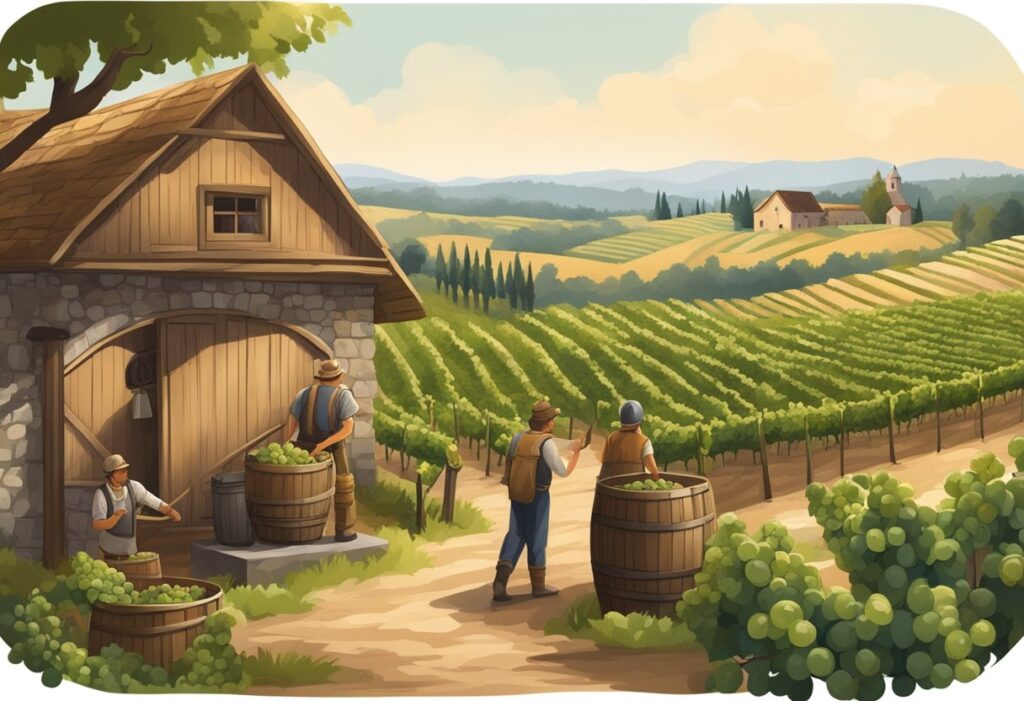
Exploring the nuances of Renaissance winemaking reveals a world where artistry met science. Quality and taste emerged through meticulous processes, from the selection of grapes to the final aging.
Grape Harvesting and Crushing
Your journey into Renaissance winemaking begins in the vineyard, where picking the grapes at their optimal ripeness was crucial for a wine’s final taste profile. Once harvested, the crushing of grapes by foot—not unlike methods from ancient winemaking techniques—was a common practice, gently extracting the juice while keeping the seeds intact to prevent bitterness.
Blending and Flavor Profile Creation
The art of blending wines in the Renaissance was as much about science as it was about taste. Winemakers had to have a deep understanding of how different grapes could combine to create a harmonious flavor profile. The process was akin to a painter mixing colors on a palette, seeking the perfect balance and depth in each glass.
Aging and Bottling
The final transformation occurred during aging, as the wine developed complexity in oak barrels or stone botti. The length of this process varied, resulting in a spectrum of outcomes from brighter, fruitier wines to those with richer, more nuanced qualities. Proper bottling was vital to preserve the wine’s character, ensuring its journey from barrel to table maintained the integrity of the winemaker’s vision.
Regional Focus: Renaissance Wine in France and Italy
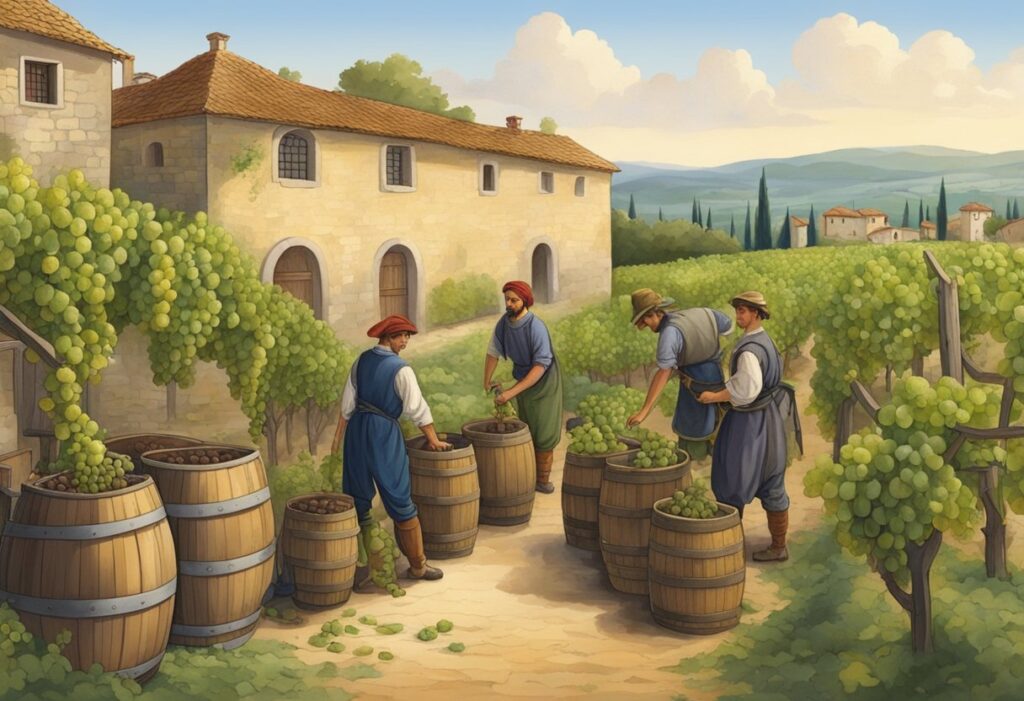
Renaissance wine-making marked a significant period of development in France and Italy, with each region offering unique contributions to the viticulture legacy. The following sections discuss the French wine heritage during this era and Italy’s rising influence in the world of wines.
French Wine Heritage During the Renaissance
During the Renaissance, France’s vineyards flourished, becoming integral to cultural and economic activities. Your appreciation for French wines might be deeply rooted in the practices established in this period, when winemakers perfected the art of producing wines that reflected the character of their regional terroir.
The adaptation of new technologies and refinement of wine varietals enhanced the complexity and appeal of French wines. This is a period where, despite the climate challenges of the Little Ice Age, quality wines started to emerge from France’s most cherished wine regions, such as Bordeaux and Burgundy.
Rise of Italian Wine Influence
Italian wine similarly experienced a transformation during the Renaissance. Italian winemakers were influenced by both domestic innovation and international methods, leading to a significant advance in the quality of wine produced.
This was not only a period marked by enhanced wine-making techniques but also saw the birth of some of Italy’s now iconic wines, including those from Tuscany. During this renaissance of Italian winemaking, experimentation led to the introduction of new grape varieties and the improvement of the vineyards, which contributed to the development of unique Italian wine profiles.
The adoption of new techniques influenced by French winemaking played a role in the wine renaissance and exploration during this dynamic period in Italy.
As you explore the history of wine, remember that the foundations for many modern wines were laid during this influential period. France and Italy are not just homes to ancient vineyards but are also cradles of winemaking innovation, with their contributions continuing to resonate in every bottle we enjoy today.
Legal and Social Aspects
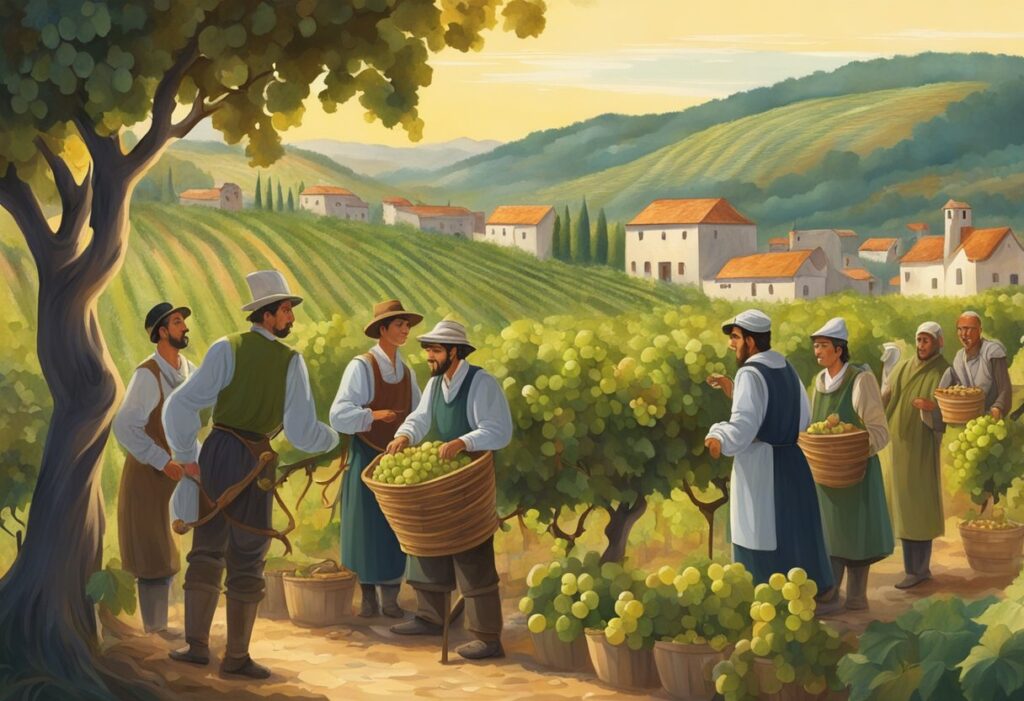
In the tapestry of Renaissance society, wine was both a marker of social hierarchy and a ceremonial staple. Laws framed wine production and consumption, while religious practices sanctified its use.
Wine Laws and Class Structures
The Renaissance period was marked by distinctive wine laws that delineated who could consume and sell wine based on social class. Legislation was enacted to regulate quality and maintain social order, with restrictions often aimed at lower economic classes.
For example, certain laws prohibited innkeepers from selling wine to the poor. These rules reinforced class structures, as wine became a symbol of wealth and status. The price of wine fluctuated accordingly, becoming a reflection of both the law’s impact and the social standing of the consumer.
Communion and Ceremonial Uses of Wine
Within the context of religion, wine held a profound significance. It was integral to Communion, representing the blood of Christ, as recalled from the Last Supper. This ceremonial use of wine extended beyond mere religious ritual, influencing social practices and norms. Its role in religious and state ceremonies underpinned its sacred status and further embedded wine in the cultural fabric of the Renaissance.
Impact on Trade and Economy
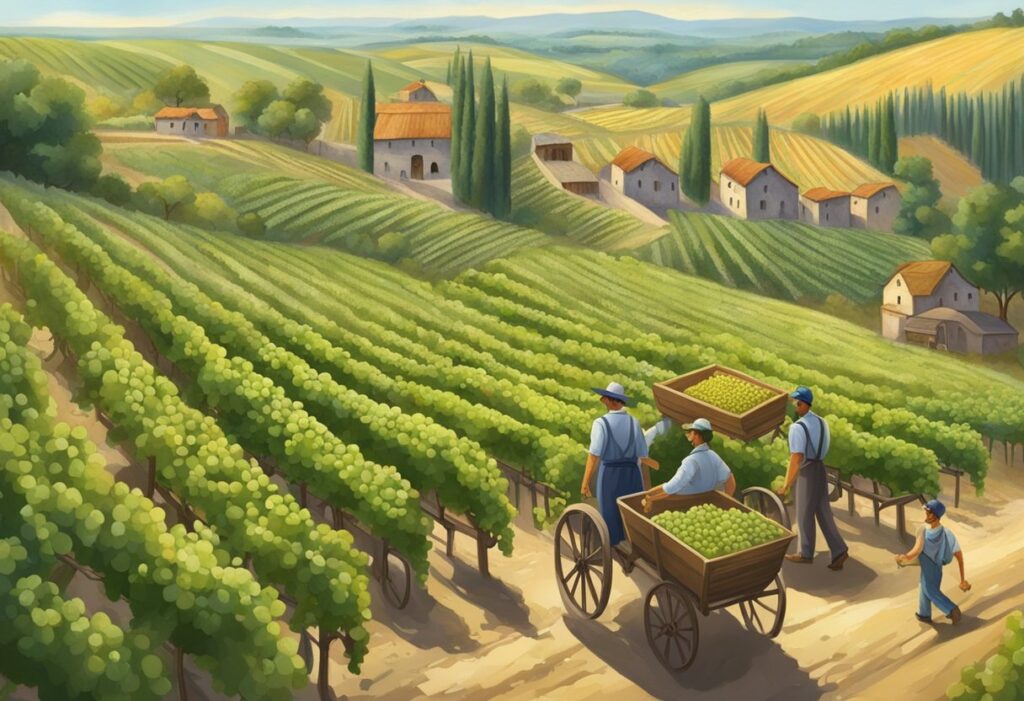
The Renaissance was a period where wine trade significantly influenced economic development and commercial relationships across Europe.
Wine Trade Routes
During the Renaissance, robust wine trade routes became instrumental to the flow of goods and cultural exchange. You would find that amphorae, used for transporting wine, played a crucial role in the distribution process.
The expansion of these routes can be linked to innovations in shipbuilding and navigational techniques, enabling the Dutch and Spanish to reach new markets with their wine exports. The development of extensive trade networks allowed for increased availability of wine, transforming it into a commodity that was traded on a scale like never before.
Exports and Economic Growth
The export of wine contributed to economic growth by creating new opportunities for wealth and employment. Your understanding of this era’s economy would not be complete without recognizing how Spanish exports, for example, penetrated far-reaching markets, bringing substantial profits to the region.
Wine emerged as a considerable export for the Spanish economy, also providing the Dutch with lucrative trading possibilities as they distributed Spanish wines throughout Europe. The profitable exchange of wine laid the foundation for what would become a significant sector, bolstering regional economies and influencing the broader economic landscape of the time.
Cultural Impact and Legacy
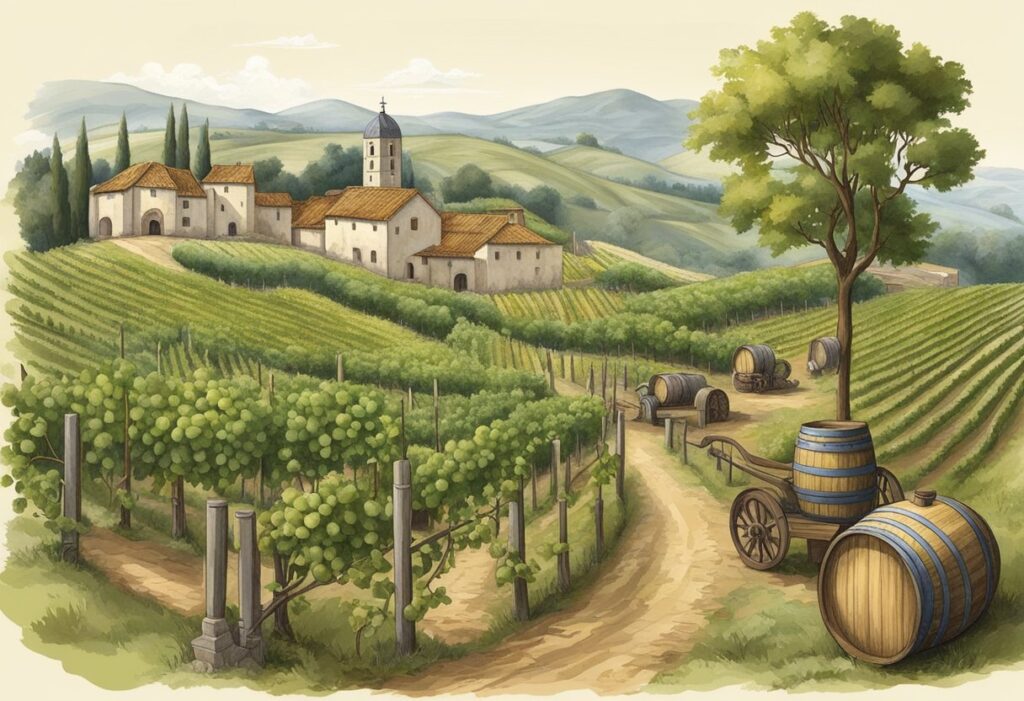
The Renaissance era was transformative, with wine permeating both the art and scholarship, leaving a legacy that echoes in your modern appreciation of viticulture.
Artistic Representations in Renaissance Art
In the realm of Renaissance art, wine often underscored themes of festivity, religion, and mythology. At the Villa dei Misteri in Pompeii, you find frescoes depicting Dionysian mysteries, where wine is a symbol of both earthly pleasure and divine ecstasy.
The depth of wine’s role is notable in these pieces as they depict how integral it was to the sociocultural fabric of the time. Additionally, wine became a frequent subject for still-life paintings, elevating it to a symbol of both affluence and the burgeoning humanist interest in the natural world.
Literary References and Documentation
Historical figures like Pliny the Elder contributed significantly to your understanding of wine-making in his time through his detailed documentation. His work “Naturalis Historia” remains a pivotal reference for you, capturing the essence of viticulture during the Renaissance.
Wine in literature also saw a surge, with many Renaissance texts mentioning wine in the context of both its enjoyment and its social implications, thus bolstering its standing in the cultural and intellectual life of the era.
Modern Relevance
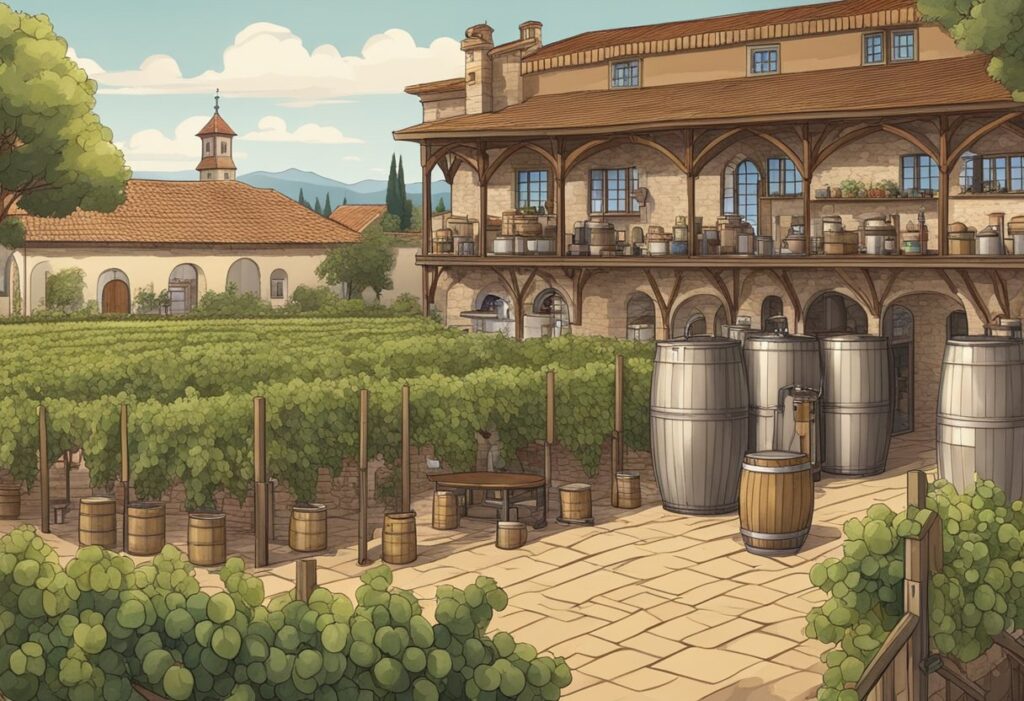
The Renaissance period continues to influence how you understand and produce wine, impacting contemporary methods and the advocacy for sustainable practices.
Inspirations in Contemporary Winemaking
Renaissance wine-making has left a spellbinding legacy, fueling the creativity of modern winemakers. You see this historical heritage reflected in the artisanal processes that prioritize quality and tradition. For example, aging wine in oak barrels—a technique popularized during the Renaissance—is still a revered practice, enhancing flavor complexity.
Renaissance Wine Techniques Today
While new technology has modernized viniculture, Renaissance methods have not been abandoned. Your awareness of climate’s impact on grape cultivation dates back to the Renaissance, as with the Little Ice Age and its influence on wine scarcity and price. You meld historic insights with modern technology to foster innovative wine production while honoring traditional practices.
Sustainable and Organic Wine Movements
In response to environmental concerns, you are witnessing a resurgence in the Renaissance ethos of working harmoniously with nature through sustainable and organic wine movements. Practices such as dry farming and minimal intervention in winemaking mirror the natural approaches of the past, ensuring a more sustainable future for viniculture.

